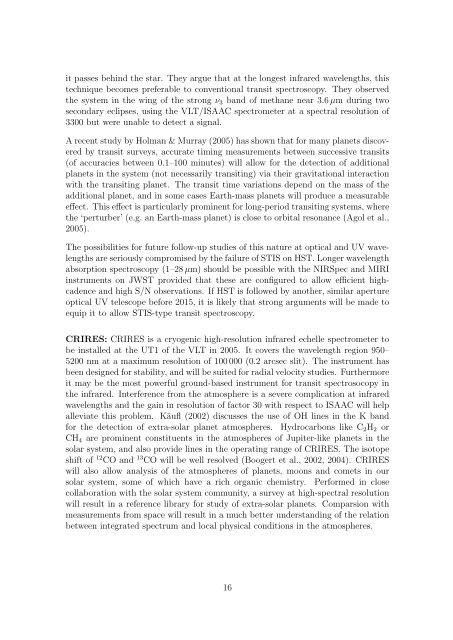Report - School of Physics
Report - School of Physics
Report - School of Physics
You also want an ePaper? Increase the reach of your titles
YUMPU automatically turns print PDFs into web optimized ePapers that Google loves.
it passes behind the star. They argue that at the longest infrared wavelengths, this<br />
technique becomes preferable to conventional transit spectroscopy. They observed<br />
the system in the wing <strong>of</strong> the strong ν 3 band <strong>of</strong> methane near 3.6 µm during two<br />
secondary eclipses, using the VLT/ISAAC spectrometer at a spectral resolution <strong>of</strong><br />
3300 but were unable to detect a signal.<br />
A recent study by Holman & Murray (2005) has shown that for many planets discovered<br />
by transit surveys, accurate timing measurements between successive transits<br />
(<strong>of</strong> accuracies between 0.1–100 minutes) will allow for the detection <strong>of</strong> additional<br />
planets in the system (not necessarily transiting) via their gravitational interaction<br />
with the transiting planet. The transit time variations depend on the mass <strong>of</strong> the<br />
additional planet, and in some cases Earth-mass planets will produce a measurable<br />
effect. This effect is particularly prominent for long-period transiting systems, where<br />
the ‘perturber’ (e.g. an Earth-mass planet) is close to orbital resonance (Agol et al.,<br />
2005).<br />
The possibilities for future follow-up studies <strong>of</strong> this nature at optical and UV wavelengths<br />
are seriously compromised by the failure <strong>of</strong> STIS on HST. Longer wavelength<br />
absorption spectroscopy (1–28 µm) should be possible with the NIRSpec and MIRI<br />
instruments on JWST provided that these are configured to allow efficient highcadence<br />
and high S/N observations. If HST is followed by another, similar aperture<br />
optical UV telescope before 2015, it is likely that strong arguments will be made to<br />
equip it to allow STIS-type transit spectroscopy.<br />
CRIRES: CRIRES is a cryogenic high-resolution infrared echelle spectrometer to<br />
be installed at the UT1 <strong>of</strong> the VLT in 2005. It covers the wavelength region 950–<br />
5200 nm at a maximum resolution <strong>of</strong> 100 000 (0.2 arcsec slit). The instrument has<br />
been designed for stability, and will be suited for radial velocity studies. Furthermore<br />
it may be the most powerful ground-based instrument for transit spectrosocopy in<br />
the infrared. Interference from the atmosphere is a severe complication at infrared<br />
wavelengths and the gain in resolution <strong>of</strong> factor 30 with respect to ISAAC will help<br />
alleviate this problem. Käufl (2002) discusses the use <strong>of</strong> OH lines in the K band<br />
for the detection <strong>of</strong> extra-solar planet atmospheres. Hydrocarbons like C 2 H 2 or<br />
CH 4 are prominent constituents in the atmospheres <strong>of</strong> Jupiter-like planets in the<br />
solar system, and also provide lines in the operating range <strong>of</strong> CRIRES. The isotope<br />
shift <strong>of</strong> 12 CO and 13 CO will be well resolved (Boogert et al., 2002, 2004). CRIRES<br />
will also allow analysis <strong>of</strong> the atmospheres <strong>of</strong> planets, moons and comets in our<br />
solar system, some <strong>of</strong> which have a rich organic chemistry. Performed in close<br />
collaboration with the solar system community, a survey at high-spectral resolution<br />
will result in a reference library for study <strong>of</strong> extra-solar planets. Comparsion with<br />
measurements from space will result in a much better understanding <strong>of</strong> the relation<br />
between integrated spectrum and local physical conditions in the atmospheres.<br />
16
















